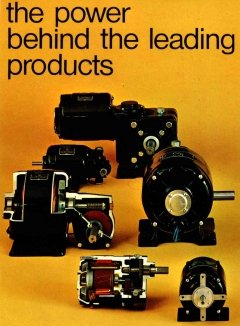We Drive the World’s Leading Products
From our first motor in 1905 to today’s solar powered motion control solutions for the energy industry, Bodine has helped thousands of customers solve application challenges, develop gearmotor and drive solutions, and deliver high-quality products.
We are committed to developing new and better ways to put our products to use in a wide range of industries and applications. To maintain our leading role, our team continually evaluate each aspect of our work. ISO 9001 certification of our quality management systems further highlights our long-term commitment to continuous improvement and to meeting the requirements of the most demanding customer applications.
A Timeline of Bodine Products
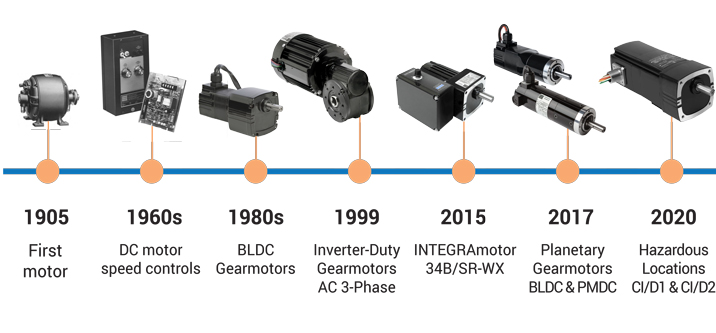
Designing and manufacturing high quality and high-performance products has been our passion for over 115 years. We are proud of our past, and we look forward to the gearmotor design challenges of the future.
To learn more, please feel free to contact us!
Bodine History
The Birth of an Enterprise
Growing up in Loomis, Nebraska, Carl and Paul Bodine, two Swedish immigrants, were fascinated by the town's first electric generator. So they began to send away for every available catalog and pamphlet to find out more about this exciting "new" source of energy.
Some years later, with the promise of jobs in Chicago, the Bodines set off for this thriving prairie metropolis.
While working various jobs in the electrical field, the brothers spent their spare time refining their motor design skills in a small workshop at Mrs. Johnson's boarding house. General purpose fractional horsepower motors were relatively new when Carl and Paul produced their first 1/20 - 1/12 hp "D-type" motors in 1905.
Just two years after they opened for business, their first custom motor job came in. An Iowa dentist, tired of his foot treadle drill, approached the Bodines during the 2nd annual Chicago Electrical Show in 1907, and asked for their help. He was so satisfied with the modified "D" motor they provided that he recommended the young men to a major dental equipment company. The Bodines had found their first large customer!
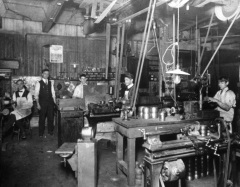
The 1920s: America SwingsBy 1927, 63% of American households had electrical power, and by 1929, it powered three-fourths of American industry. The first consumer radios were introduced in 1920, and within a decade found a place in more than 12 million homes. Bodine entered the booming radio market in 1924 with a specially designed loop aerial antenna. Phonographs represented another breakthrough in communications. But the early phonographs had several drawbacks: cranking the old Victrolas was a chore, and the new electric turntables were continually breaking down. After extensive testing, Bodine engineers developed a quiet, dependable turntable which maintained a constant speed. Within a year of its introduction, Bodine's RC-10 motor claimed a fifth of the company's sales, with many going to the growing new audio industry. In 1928, Seeburg purchased Bodine motors for their first commercial phonograph - the jukebox. |
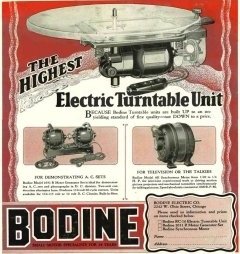
The Lean Years
The crash of the stock market in October of 1929 had a devastating impact on American life. While production and incomes sank to record lows, American resourcefulness and ingenuity took over. Bodine’s business dropped sharply between 1929 and 1933, but the company managed to hold on. A contract to make motor parts for Sunbeam's new food mixers provided jobs for factory employees, while the engineering team began to improve existing motor designs.
Bodine's "N" motors were designed during the early 1930s, and made a significant contribution to the fractional horsepower motor market. The new line was particularly useful for driving office machines, scientific instruments and recording equipment. The "N-line" offered several sales advantages: they were quieter, performed better, and most importantly, were designed with interchangeable frame sizes for both AC and DC operation.
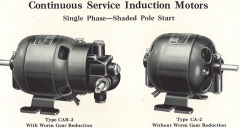
The War Years
World War II provided the U.S. economy with a new sense of purpose. Electric motors were critical to industrial and military equipment. But, unfortunately, magnet wire, ball bearings, steel, copper, and aluminum were all in short supply. People were also in short supply. Like many other manufacturers, Bodine turned to women to keep production running. By 1945, women represented 45% of the company's workforce. And the early 1940s were not all about military supplies. Bodine motors were also part of the 8 million volt atom smasher at Notre Dame, and the advanced astronomical equipment at the Fremont Pass observatory station in Colorado.

The Boom Years
The end of World War II marked the beginning of an automated America. People had money to spend, goods that were scarce became plentiful, and people were fascinated by new gadgets and machines. The most popular new product of the late 1940s and early 1950s was, of course, the television set. Electrical machines and appliances became part of everyday life, electrical energy use increased by 333% between 1940 and 1954. Bodine found many new and expanding markets, for example, automated office equipment. One of the most significant introductions was the "K-4" motor, used in the first Royal electric typewriter. The "K-4" series was quieter than competitor’s motors, and it gave off no radio interference to affect neighboring machines. Bodine also supplied motors for calculators, duplicating equipment, and adding and mailroom machines.
Perhaps the most exciting development in office equipment came in the late 1950s when the Haloid Corporation approached Bodine to provide a motor for a new kind of copying machine. Bodine supplied the motor for the first of what was to be called the "Xerox®" machine (photo: Xerox 914).
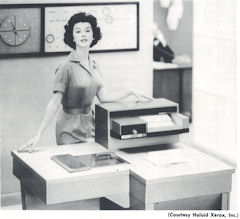
The 1960s, 1970s, and 1980s
In the 1960s, Bodine entered the rapidly developing electronics field with a new line of silicon controlled rectifier (SCR) DC motor speed controls.
The early 1970s saw the introduction of Bodine's permanent magnet (PM) DC motors and gearmotors. These efficient new PMDC motors and gearmotors met industry demands for a smaller and more powerful DC motor, especially in applications like welding apparatus and elevator door openers.
In the late 1980s, Bodine Electric developed and introduced its first brushless DC (BLDC) motors, gearmotors, and BLDC motor speed controls. Metric motors and gearmotors were another 1980s product line expansion. Bodine was the first American manufacturer to produce fractional horsepower (FHP) motors to international standards.
